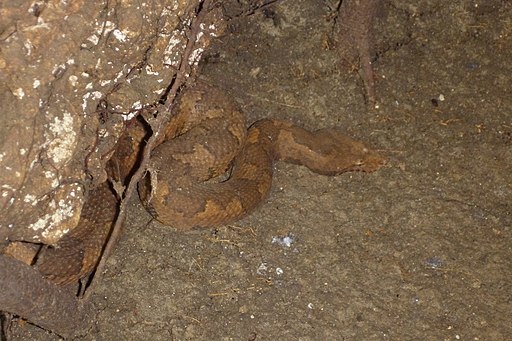Superregnum: Eukaryota
Regnum: Animalia
Subregnum: Eumetazoa
Cladus: Bilateria
Cladus: Nephrozoa
Superphylum: Deuterostomia
Phylum: Chordata
Cladus: Craniata
Subphylum: Vertebrata
Infraphylum: Gnathostomata
Superclassis: Tetrapoda
Cladus: Reptiliomorpha
Cladus: Amniota
Classis: Reptilia
Cladus: Eureptilia
Cladus: Romeriida
Subclassis: Diapsida
Cladus: Sauria
Infraclassis: Lepidosauromorpha
Superordo: Lepidosauria
Ordo: Squamata
Subordo: Serpentes
Superfamilia: Booidea
Familia: Boidae
Subfamilia: Boinae
Genus: Candoia
Species: Candoia aspera
Name
Candoia aspera (Günther, 1877)
Vernacular names
Bahasa Indonesia: Boa tanah
polski: Boa nowogwinejski
Candoia aspera, known commonly as the viper boa or New Guinea ground boa, is a species of snake in the family Boidae.[1] As its common name suggests, it is found in New Guinea. They are a terrestrial species, living in the undergrowth. They are smaller than some other members of the Boidae family. Viper boas grow to 2 to 3 feet in length. They are known to be primarily nocturnal. Viper boas are known to be slightly more aggressive than other Candoia. In recent years they've become increasingly scarce in the pet industry, due to restrictions on import/export trading. Though they were more common in the past, there is still very little known about them, in particular their behaviour in the wild. For example; Their lifespan is still undetermined. It got the nickname viper boa from its appearance. They look extremely similar to the elapid species Acanthophis laevis, more commonly known as the "Papuan death adder." The death adder itself only resembles a viper, but is actually an elapid. However, because of the resemblance to the highly venomous death adder, many are killed out of fear although they are harmless.
References
"Candoia". Integrated Taxonomic Information System. Retrieved August 10, 2010.
Retrieved from "http://en.wikipedia.org/"
All text is available under the terms of the GNU Free Documentation License


